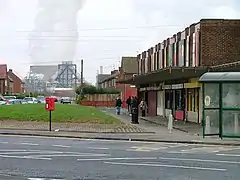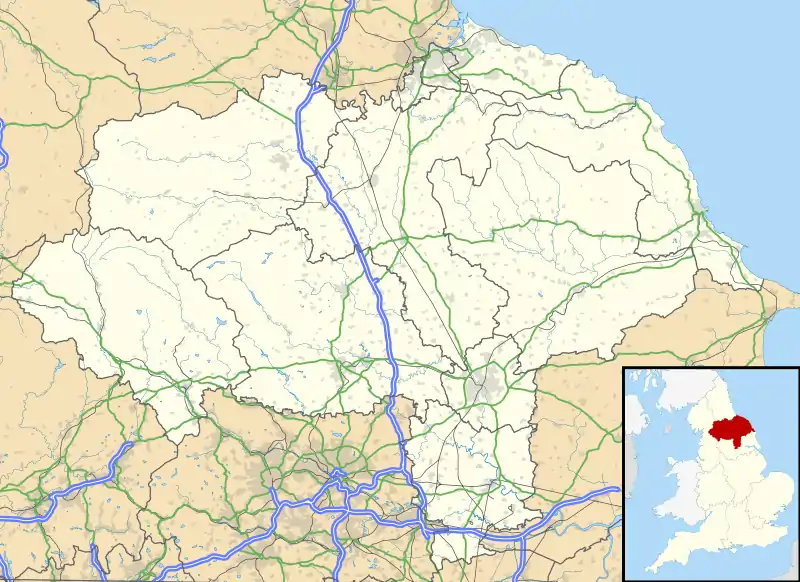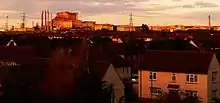Grangetown, North Yorkshire
Grangetown is a town in the borough of Redcar and Cleveland, North Yorkshire, England.
| Grangetown | |
|---|---|
 Slater Road shops, Grangetown | |
 Grangetown Location within North Yorkshire | |
| Population | 5,088 (2011.ward)[1] |
| OS grid reference | NZ554209 |
| Unitary authority | |
| Ceremonial county | |
| Region | |
| Country | England |
| Sovereign state | United Kingdom |
| Post town | MIDDLESBROUGH |
| Postcode district | TS6 |
| Dialling code | 01642 |
| Police | Cleveland |
| Fire | Cleveland |
| Ambulance | North East |
| UK Parliament | |
Geography and history

Grangetown is on the eastern outskirts of Middlesbrough, beyond South Bank, 3 miles (4.8 km) east of Middlesbrough town centre and 4 miles (6.4 km) from Redcar.[2] It was historically part of the ancient wapentake of Langbaurgh West, which along with Langbaurgh East formed the Cleveland area of North Yorkshire, then the parish and urban district of Eston. Grangetown was brought into Teesside County Borough in 1968; from 1974 to 1996, it formed part of the County of Cleveland, and in 1996 it became part of the Unitary Authority of Redcar and Cleveland, which replaced the district of Langbaurgh-on-Tees. It has a population of approximately 8,000.
The impetus for the development of Grangetown was the discovery of ironstone in the Eston Hills in 1840, and the subsequent development of the iron and steel industry along the riverbanks by Messrs. Bolckow and Vaughan. By 1914, it was community of approximately 5,500 people with the majority of the houses lying between Bolckow Road and the steel works. There was a market square, shopping centre, boarding school, three pubs, six places of worship, a police station and public bathhouse. Though the inhabitants came from many parts of the country, the community had built up a strong identity and local pride. The majority of men worked in the steel works, but a wide range of skills was represented within the town and a whole cross-section of society lived together in the town.

Grangetown underwent a period of quite rapid expansion between 1914 and 1939. Both the steel companies and the local council built estates from Bolckow Road to and across the new A1085 Trunk Road. The population in 1939 was approximately 9,000. After the war, council house building was extended and in the 1950s reached Fabian Road.
The modern town has long since moved from its original location. Victorian terraced houses, nestled against the heavy industry along the River Tees have been replaced with the warehouses and depots of lighter industry. Some new houses have been built over the years, but Grangetown has lost the popularity of its heyday in the earlier part of the 20th century. The local authority, Redcar and Cleveland Council have embarked on the regeneration project named Greater Eston.
Politics
Grangetown is part of Redcar constituency and is represented by Conservative Member Jacob Young in the House of Commons.
Borough Council
In the 2015 local elections, the following members were returned to Redcar and Cleveland Borough Council:[3]
| Ward | Councillor | Party | |
|---|---|---|---|
| Grangetown | Jade Stainthorpe | Labour Party | |
| Grangetown | Lynn Pallister | Labour Party | |
Notable people
- Eddie Latheron (1887–1917), Blackburn Rovers and England footballer
- William Henry Short V.C. (1884-1916), footballer and Battle of the Somme VC recipient
- Horace King, Baron Maybray-King (1901–1986), former Labour Party MP and Speaker of the House of Commons
- Wally K. Daly (born c. 1941), television and radio writer
- Alan Keen (1937-2011), former Labour Party MP
- Roy Chubby Brown (born Roy Vasey, 1945) stand up comedian[4]
Location
References
- "Redcar and Cleveland population 2011". Retrieved 23 July 2015.
- "2011 UK Census statistics". Retrieved 23 September 2013.
- "Redcar & Cleveland". May 2011. Archived from the original on 31 May 2011. Retrieved 3 April 2014.
- "Who the f*** is Chubby?". BBC Tees. 29 October 2014. Retrieved 27 December 2016.
External links
| Wikimedia Commons has media related to Grangetown, North Yorkshire. |
- Grangetown in Past Times
- Genuki - History of Eston parish & District Descriptions from Bulmer's History and Directory of North Yorkshire (1890), retrieved 8 February 2006